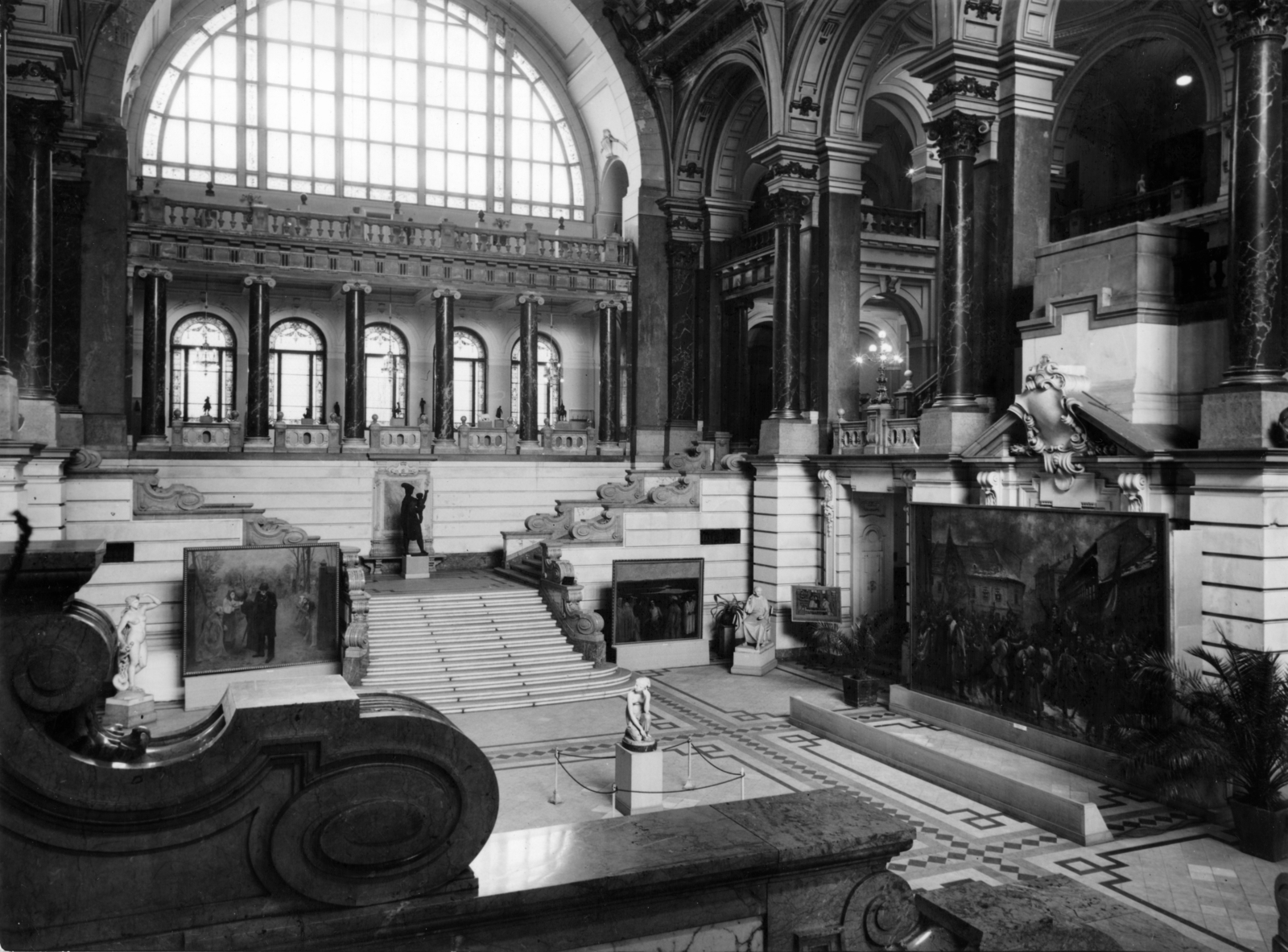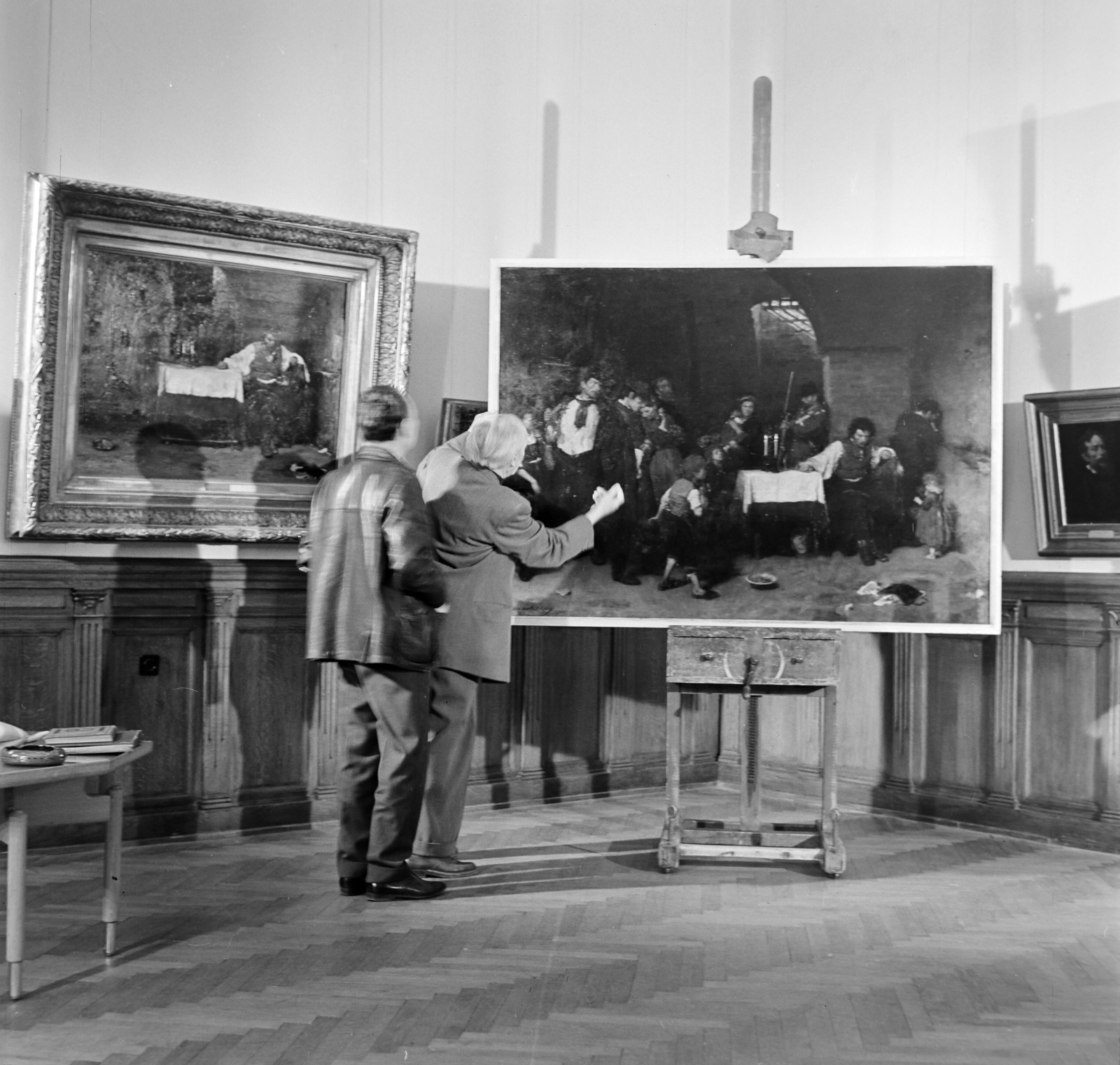At the beginning of the 20th century, outstanding works of Hungarian art were part of the collection of the Museum of Fine Arts. However, due to the limitations of the building, they could not properly present the works of Hungarian masters, so in the 1920s, Elek Petrovics, the then director general of the Museum of Fine Arts, advocated that an exhibition of the works of Hungarian artists be made in the old Kunsthalle [Műcsarnok] building on Andrássy Avenue. This is how the New Hungarian Gallery of the Museum of Fine Arts was founded in 1928.
"Now it is finally guaranteed that this branch gallery of the museum will open in October, which will be a representative home for modern Hungarian art"
- the words of Elek Petrovics were quoted by the magazine Az Est on 3 October 1928.
The exhibition of the New Hungarian Gallery of the Museum of Fine Arts was opened in the old Kunsthalle building in 1928 (Source: Magyar Művészet, Issue 8, 1928)
But even this decision could only temporarily remedy the problem caused by the lack of space. Gábor Pogány Ö., the first director of the Hungarian National Gallery wrote about this later in the year of the establishment of the institution, on 12 April 1957, in the columns of the magazine Élet és Irodalom.
"The museum situation continued to deteriorate from decade to decade. Paradoxically with the fact that our artists have created more lasting works due to the rapid development of our visual arts. The warehouses became more and more full, and the exhibition opportunities proved to be unwaveringly scarce. The importance of our national art of painting, sculpture, and graphics grew rapidly, but it was presented to the public only insufficiently, truncated [...]"

The Curia's building in 1959, the first home of the Hungarian National Gallery (Source: Fortepan/No.: 59546)
The idea that there is a need for an independent institution with an independent building where the masterpieces of Hungarian art can be properly presented took shape. To this end, the long-awaited Hungarian National Gallery was created, and the instructions for its establishment were published in the Művelődésügyi Közlöny on 1 June 1957:
"By merging the New Hungarian Gallery of the Museum of Fine Arts, the Hungarian collection of its modern sculpture department and graphics department, and the Hungarian coins collection, the Hungarian National Gallery is created, which is an independent national museum of Hungarian fine art."

The hall of the Hungarian National Gallery in 1959 with Gyula Benczúr's painting "Budavár visszavétele 1868-ban" [Recapture of Buda Castle in 1686] (Source: Fortepan/No.: 155880)

The hall from 1963, in the foreground with István Ferenczy's painting "Pásztorlányka" [Shepherdess], behind János Thorma's painting "A szenvedők" [The Sufferers] and Károly Ferenczy's painting "Józsefet eladják testvérei" [Joseph is sold by his brothers] (Source: Fortepan/No.: 155860)
In the already quoted article, Gábor Pogány Ö. also mentioned that another lucky circumstance contributed to the creation of the institution: they found the right building. The former Curia, built in 1896, proved to be suitable for accommodating the gallery's collections.
In his ministerial decree dated 7 November 1891, the Minister of Justice entrusted Alajos Hauszmann with the design of the Curia's palace. According to the construction program, the building had to include not only the royal Curia but also the Budapest Court of Appeal, the general prosecutor's office and the premises of the crown prosecutor's office. Hauszmann himself wrote about this in the Magyar Mérnök- és Építész Egylet Közlönye [Journal of the Hungarian Society of Engineers and Architects] in 1897.

Exhibition rooms in the Curia's building from 1959 (Source: Fortepan/No.: 155882)

Exhibition space with Pál Szinyei Merse's painting Majális [May Day] on the wall from 1964 (Source: Fortepan/No.: 155888)
Hauszmann started to develop the plans as early as 1892, but the final version was completed only one year later, in 1893. The building was ceremoniously handed over on 20 October 1896.
"It is a modern building in every way, but it relies on the elements and proportions of ancient architecture. The central Corinthian colonnade and the Ionic colonnade running along both sides reflect the architecture of classical antiquity; the pediment, the triga group at the top of the facade, and the giant vault of the vestibule resemble the best examples of old Rome.”
– the Vasárnapi Ujság praised the building on 25 October 1896.

The gallery's art storage from 1960 (Source: Fortepan/No.: 155886)

Restoration studio from 1965. Mihály Munkácsy's painting Siralomház on the easel (Source: Fortepan/No.: 178316)
In terms of the building's exterior and interior decoration, it represents an exceptional value in the capital's architecture. In the tympanum of the facade, György Zala's three-part work can be seen: in the middle, a court hearing comes to life, and on both sides, the allegorical figure of Law Teaching and Law Making can be seen. Above the tympanum, the figure of the Genius standing on a three-horse triumphal chariot was modelled by Károly Senyei. Among the sculptures on the facade, we can also find works by József Róna and Gyula Donáth.
The vault of the great hall is decorated with a painting by Károly Lotz: in the middle is Justitia, the Roman goddess of justice, on the right side is the allegorical figure of the protection of the law, and on the left is the allegorical figure of judgement. Opposite the entrance was Alajos Stróbl's Justitia statue, which was removed when the function of the building changed.

Building B of the Hungarian National Gallery in the year before the handover, in 1974 (Source: Fortepan/No.: 155938)

Opening of the Hungarian National Gallery in the Buda Castle on 12 October 1975. In the picture, the director, Gábor Pogány Ö. can be seen wearing a polka-dotted tie. (Source: Fortepan/No.: 155933)
The Hungarian National Gallery moved into the building in 1957 by dividing the building into two: the southern wing housed the Party History Institute of the MSZMP, [Hungarian Socialist Workers' Party, the ruling party at that time] and the gallery opened its doors in the northern wing.
In the meantime, the government had already decided that the Buda Castle, which suffered extremely heavy war damage, would be turned into a cultural quarter, where preservation and archaeological works were already being carried out under the leadership of László Gerevich. In 1959, it was finally decided that the Hungarian National Gallery would take over buildings B, C and D after their restoration.

The exhibition space of the Hungarian National Gallery in the Buda Castle (Source: Fortepan/No.: 145351)
The palace was seriously damaged during the siege from Christmas 1944 to 11 February 1945. Almost nothing remained of the original interior spaces, so radical changes were made in the wings of the building. The leading interior designer, István Németh, had to take into account the needs of the museums moving here. Adequate space had to be provided for exhibition spaces, warehouses, offices, workshops and visitors. The interior spaces were uniformly characterised by the walls made of marble-imitating limestone from Süttő, the floors made of red marble from Tardos, grey marble pedestals and stairs, and copper railings - as we can read about in the study Múzeumi beruházások a hatvanas években Budapesten [Museum investments in Budapest in the 1960s] by Emőke Gréczi in the 85th issue of MúzeumCafé.

The exhibition hall of the gallery (Source: Fortepan/No.: 144202)
When the building was ready to accommodate the collections, the move began, which was reported by the Népszava magazine on 26 July 1975 as follows:
"Most of the collection of the Hungarian National Gallery was moved to the Buda Castle. These days, the material of the storage room, next week the old Hungarian works of art will be delivered. Only the permanent exhibition of 19th-century paintings will remain in the Kossuth Lajos Square building until the new home creates favourable conditions for the high-value works."

Delivery of paintings to the Hungarian National Gallery. In the picture, Mihály Munkácsy's painting "Anya gyermekével" [Mother with her child] is being taken out of the car (Source: Fortepan/No.: 66364)
"First, as a result of decades of restoration work, the Budapest History Museum was able to welcome the public, and then, in honour of the thirtieth anniversary of our country's liberation, the Museum of the Institution of the Hungarian Labour Movement opened its doors. Now the central part of the palace is being inaugurated, which will now be the permanent home of the Hungarian National Gallery. Under the new circumstances, the museum serving the cause of Hungarian fine art culture can serve the cause of our national culture in a dignified environment, in a more versatile way, and can introduce visitors from home and abroad to the history of Hungarian fine art and its most famous artists"
- wrote the newspaper Hétfői Hírek on 13 October 1975, on the occasion of the opening of the gallery.
The first exhibition organised in the palace commemorated the 125-year-old painting colony in Szolnok, and it was followed by a number of similar large-scale exhibitions, which were also housed in Building A from 2005: after the Ludwig Museum moved out, the Hungarian National Gallery was able to use part of the building.

Buildings B and C of the Hungarian National Gallery nowadays (Photo: Balázs Both/pestbuda)
Currently, within the framework of the National Hauszmann Program, they are working to restore the palace to its pre-war condition. For this reason, the cultural institutions in the palace, including the Hungarian National Gallery, will have to move out of their previous home. Its new location was designated in the City Park, on the former site of the Petőfi Hall. The plans for the building - which will present the modern-day material of the Museum of Fine Arts and the Hungarian National Gallery merged in 2012, according to the preliminary plans - were prepared by the Japanese architecture firm SANAA. Construction has not started yet.
Design render of the New National Gallery building (Source: ligetbudapest.hu)
Cover photo: The main entrance of the Hungarian National Gallery (Photo: Balázs Both/pestbuda)





































Hozzászólások
Log in or register to comment!
Login Registration